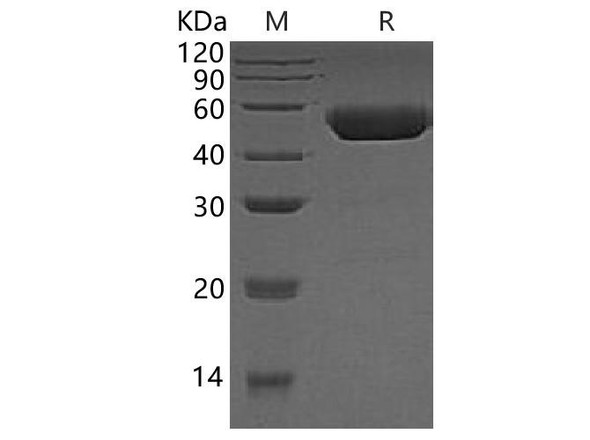Enzymes Recombinant Proteins
Human CTSD Recombinant Protein (RPPB1515)
- SKU:
- RPPB1515
- Product Type:
- Recombinant Protein
- Species:
- Human
- Uniprot:
- P07339
- Research Area:
- Enzymes
Description
| Product Name: | Human CTSD Recombinant Protein |
| Product Code: | RPPB1515 |
| Size: | 10µg |
| Species: | Human |
| Target: | CTSD |
| Synonyms: | Cathepsin D, EC 3.4.23.5, CTSD, CPSD, CLN10, MGC2311. |
| Source: | Escherichia Coli |
| Physical Appearance: | Sterile Filtered clear solution. |
| Formulation: | Cathepsin D at 0.1mg/ml in 50mM Tris-Acetate, pH7.5, 1mM EDTA and 20% Glycerol. |
| Stability: | Store vial at -20°C to -80°C. When stored at the recommended temperature, this protein is stable for 12 months.Please prevent freeze-thaw cycles. |
Cathepsin D is synthesized as a 54kDa precursor, which is proteolytically processed to an intermediate 48kDa single chain, which matures into more stable 34kDa and 14kDa two chain form. It is an estrogen-regulated lysosomal protease that has been suggested to facilitate cancer cell migration and invasion by digesting the basement membrane, extracellular matrix, and xonnective tissue. Because of its mitogenic and proteolytic activities, it has been implicated as a prognostic marker in many tumor types. Cathepsin D is expressed in epithelial cells as well as in macrophages.
Catheprsin D Human Recombinant full length protein expressed in E.coli, shows a 48 kDa band on SDS-PAGE. The Catheprsin D is purified by proprietary chromatographic techniques.
| UniProt Protein Function: | CTSD: Acid protease active in intracellular protein breakdown. Involved in the pathogenesis of several diseases such as breast cancer and possibly Alzheimer disease. Consists of a light chain and a heavy chain. Belongs to the peptidase A1 family. |
| UniProt Protein Details: | Protein type:Autophagy; Motility/polarity/chemotaxis; Protease; EC 3.4.23.5 Chromosomal Location of Human Ortholog: 11p15.5 Cellular Component: extracellular matrix; extracellular space; lysosomal lumen; lysosome; melanosome; extracellular region Molecular Function:protein binding; aspartic-type endopeptidase activity Biological Process: collagen catabolic process; extracellular matrix disassembly; extracellular matrix organization and biogenesis; antigen processing and presentation of exogenous peptide antigen via MHC class II; proteolysis Disease: Ceroid Lipofuscinosis, Neuronal, 10 |
| NCBI Summary: | This gene encodes a lysosomal aspartyl protease composed of a dimer of disulfide-linked heavy and light chains, both produced from a single protein precursor. This proteinase, which is a member of the peptidase C1 family, has a specificity similar to but narrower than that of pepsin A. Transcription of this gene is initiated from several sites, including one which is a start site for an estrogen-regulated transcript. Mutations in this gene are involved in the pathogenesis of several diseases, including breast cancer and possibly Alzheimer disease. [provided by RefSeq, Jul 2008] |
| UniProt Code: | P07339 |
| NCBI GenInfo Identifier: | 115717 |
| NCBI Gene ID: | 1509 |
| NCBI Accession: | P07339.1 |
| UniProt Secondary Accession: | P07339,Q6IB57, |
| UniProt Related Accession: | P07339 |
| Molecular Weight: | 44,552 Da |
| NCBI Full Name: | Cathepsin D |
| NCBI Synonym Full Names: | cathepsin D |
| NCBI Official Symbol: | CTSD�� |
| NCBI Official Synonym Symbols: | CPSD; CLN10; HEL-S-130P�� |
| NCBI Protein Information: | cathepsin D; lysosomal aspartyl protease; lysosomal aspartyl peptidase; ceroid-lipofuscinosis, neuronal 10; epididymis secretory sperm binding protein Li 130P |
| UniProt Protein Name: | Cathepsin D |
| Protein Family: | Cathepsin |
| UniProt Gene Name: | CTSD�� |
| UniProt Entry Name: | CATD_HUMAN |






